See also:
- Book review of Tarot of The Holy Light: A Continental Esoteric Tarot
- Book review of Foundations of the Esoteric Traditions
Back in 2011, Christine Payne-Towler came out with Tarot of the Holy Light, illustrated by comic book artist Michael Dowers. It was self-published by her via Noreah Press.
However, for reasons unbeknownst to me, I didn’t become aware of the deck’s existence until last year. You can order the deck over at Tarot University. This deck, along with Christine Payne-Towler, is going down in tarot history, mark my words, and while far be it for me to tell you what to do, I’d get a copy of this deck while it’s still available.

Anyone who has explored esoteric tarot has heard of Christine Payne-Towler. She’s written some of the most compelling, provocative articles on tarot scholarship available, many of which you can find at Tarot.com or at ArkLetters. Payne-Towler is one of my tarot heroines.
Much of Payne-Towler’s scholarly work explores the Western occult cosmological principle that astrology, gematria (in particular with the Hebrew alphabet), and numerology can be reconciled cohesively to express the divine. You’re going to see the synthesis of astrology and gematria quite clearly in Tarot of the Holy Light (THL from now on).
According to her findings, in the 18th century, French Martinists and Freemasons synthesized the three correspondences into the tarot. The THL is a contemporary deck that pays tribute to that esoteric synthesis of astrology, gematria, and numerology. The deck is structured accordingly, and uses artwork from 17th century alchemists in a digital collage style.
Yet I promise you that you won’t even notice that the art is digital collage. Payne-Towler and Dowers use alchemical art and illustrations from the 1600s and cite their sources. There’s Jakob Bohme, a German Christian mystic; Robert Fludd, a physician, astrologer, Qabalist, and Rosicrucian; the celebrated polymath Athanasius Kircher, given the title “Master of a Hundred Arts,” and– super cool– wrote scholarly work on the Nestorian Christians, a topic close to my heart; and many more.
The deck quality is great. It’s 3.25″ x 5.00″, which makes it significantly wider and slightly taller than typical tarot decks. Given the intricate detailing on this deck and its reliance on esoteric symbolism, you’re going to appreciate having the larger size. However, it’s smaller than the DruidCraft Tarot (if you’re familiar with that one) or any of the Hay House oracle decks, just to give you a sense of sizing. The cardstock is semi-glossy, firm, with a good weight to it.
The one thing to prepare for is that this deck is its own unique tradition. While it’s definitely an esoteric tarot deck on all the structural and architectural design points (following what Payne-Towler refers to as the Continental Tarots, with Key 8 as Justice and Key 11 as Strength), and you’re going to see strong Etteilla and Papus influences, you would not be serving this deck any justice if you simply transplant your card meanings repertoire from one of the other established traditions.
Yes, there’s some cross-over in both card imagery and meanings (per the LWB) with Marseille, RWS (see, e.g., the 4 of Swords), and Thoth (see, e.g., the 2 of Disks), but Tarot of the Holy Light won’t fit snugly into the compartment of any one of those single traditions. If you want to read well with this deck, be prepared to go back to the basics as a beginner and re-learn tarot like a beginner.
(And yet this is no beginner’s deck.)
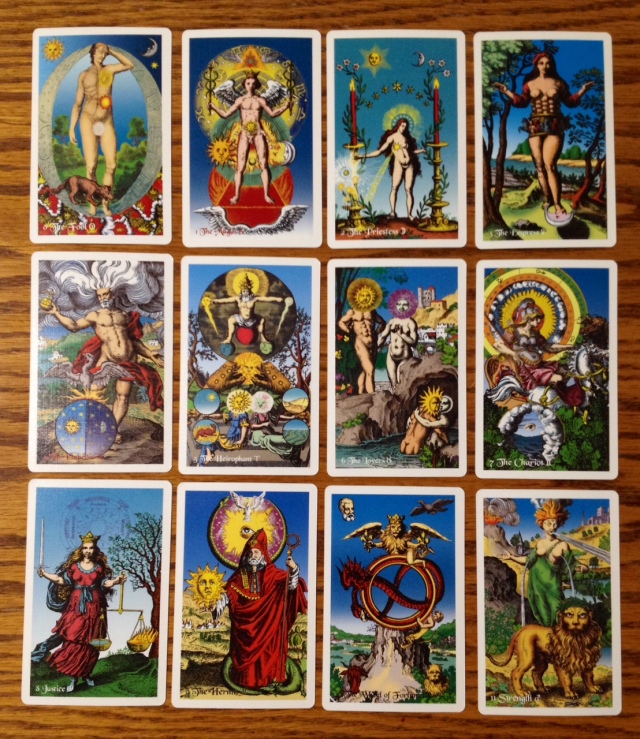
The card imagery is not for the uninitiated. Take The Empress, for example. She is a voluptuous woman with what looks like at least 21 full breasts, hooved creatures galloping out of her belly, and her left foot stepping on the face of a crescent moon, all with a serene Mona Lisa smile on her lips. The Queen of Cups is a winged serpent-mermaid with two tails, and she’s squirting streams of water out of her nipples.

Yet the Death card and The Devil in THL are some of my favorite if not favorite representations of Death and The Devil I have ever come across. My photos in this posting are blurry. You have to see these cards in person and hold them in your hands to get the full effect. The colors are vivid, the symbolism intense, and there’s great movement in the cards, yes, movement. You stare long enough at the ocean waves and they seem to move. The rays of the suns seem to flicker. That is testament to a strong, innate reverberating energy that these cards are giving off.
You are going to see a lot of Martinism, Rosicrucianism, and Christian esoteric symbology throughout the deck’s imagery. Revisiting 18th century books on alchemy and Christian mysticism is– I dare say– a must. Proficiency at Western astrology is also a must, or you risk missing out on a significant dimension of the deck’s proffered insights.
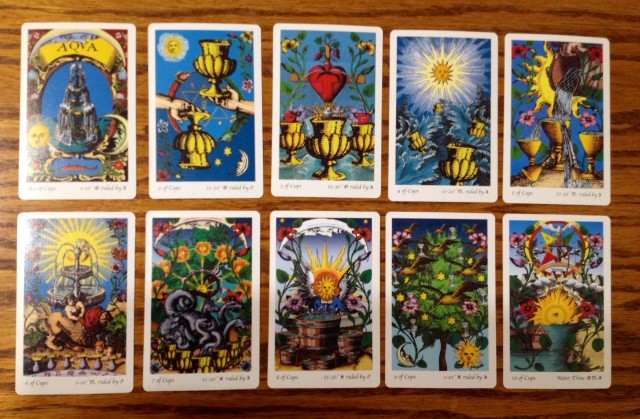
The bottom right corner of each card includes an astrological reference caption, which vary significantly from the English Tarot traditions of astrological attributions. I’m borrowing terms from Payne-Towler now, referring to the Rider-Waite-Smith and Thoth decks as English Tarots. Payne-Towler critiques the English decks, such as the Rider-Waite-Smith and Thoth, and makes no secret of her preference for what she calls the Continental Tarots, or decks created in the European tradition before the 19th century. I tend to refer to these as the Marseille decks, admittedly an imperfect and overly generalized label.
Like what you may be used to under the English esoteric tarot tradition, the pip cards in THL correspond with the 36 decans, except under THL, it’s the Aces to 9s that correspond with the decans. Under English esoteric traditions, Aces are thought of as the root of a primal element (e.g., Ace of Wands is the Root of Primal Fire, so it’s the elemental Fire only, not a decan). See Book T as reference. In the THL, Aces correspond with decans, whereas the 10s are elementals (e.g., 10 of Swords is Air, and on the card, you’ll see the glyphs for Libra, Aquarius, and Gemini).
Oh–very quicky, the decans– the 12 zodiac Signs are subdivided into thirds of 10 degrees each, and each of these subdivisions are called decans (sometimes decanates). These decans are each then assigned a supplemental planetary rulership and are essential fundamentals in esoteric tarot. The decanate attributions in the THL differ, though. In English esoteric traditions, for example, the 4 of Pentacles is Sun in Capricorn. In THL, the 4 of Disks is 11-20 degrees Taurus, ruled by Mercury.
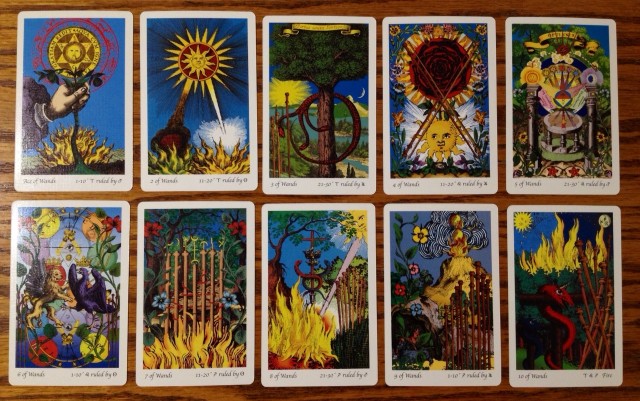
I’ve been working with these cards for the last few months pretty intensely and have been getting crazy accurate results. The synchronicities you will experience with this deck will kind of freak you out in fact. Recently I did a reading for a well-known public figure, a female who was going through a tense situation and the cards drawn caused all parties involved to take a step back. And I threw my hands up and immediately began sputtering, “Omigosh, I swear I did not rig the cards, omigosh on my honor, under penalty of perjury… seriously. Not rigged.”
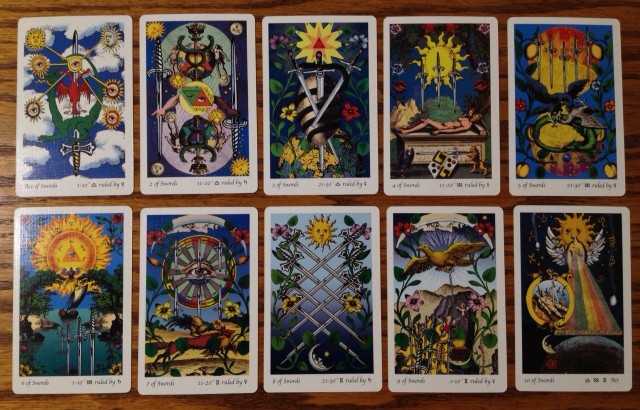
The Minors in the THL are among my favorites of all time in terms of illustrations. You’ll want to pay close attention to the symbolism, like the lion-bird dynamic repeated in the 6 of Wands or 9 of Disks, sun and moon binary in select cards, like the 8 of Swords and 10 of Swords pictured above, the all-seeing eye in the Ace of Disks, 6 of Swords, or 7 of Swords, just to name three, the caduceus in The Magus, 8 of Wands, but not in the 2 of Cups as it would be in the RWS, and many more details that cannot be overlooked when reading with the THL. Many of the colored orbs depicted in the cards remind me of the seven chakras, such as in the 9 of Disks, so for those reading intuitively, color symbolism can become critical in interpreting overarching energies.
The astrological attributions in the courts also differ. Typically under the English system, the whole court from the suit is ascribed the three zodiac signs corresponding with the suit’s element. So for the suit of Cups under the English system, Page, Knight, Queen, and King of Cups are all Cancer, Scorpio, and Pisces. Seasonally, all four court cards in the suit correspond with Summer.
In THL, they’re separated out. The Page is a seasonal card, and so the Page of Cups would be ascribed Summer. The Knights all represent their corresponding Mutable Signs, the Queens are the Cardinal Signs, and the Kings are the Fixed Signs. Thus, in the Knight of Cups is Pisces, the Mutable Water Sign. The Queen of Cups is Cancer, the Cardinal Water Sign. And the King of Cups is Scorpio, the Fixed Water Sign.
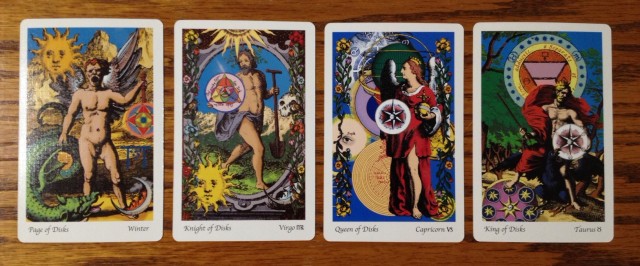
I read in a review by veteran-and-super-awesome-tarot-grandmaster Bonnie Cehovet that the artist (Michael Dowers) incorporated Christine Payne-Towler’s initials on the Queen of Swords, because that’s her signifier. Incidentally, the Queen of Swords is also my signifier. Cool!
Ultimately, this is not going to be an easy deck to work with. In fact I’m pretty sure you need an IQ of 200 to even begin working competently with it. I wouldn’t recommend it as a beginner’s deck. However, anyone pursuing esoteric studies must get Tarot of the Holy Light. What this deck does extraordinarily well is teach the concept of unity (the “As Above, So Below” Hermetic understanding), and train the practitioner to begin seeing metaphysical correlations on a mascroscopic level.
Yes, of course you can use this deck for fortune telling or psychological ruminations or everyday readings. Payne-Towler is the first to say that this deck is also created to operate effectively in those capacities. She has also talked about how she intended the THL to be used for scrying. I’ve found that my way of reading this deck does fall into the practice of scrying. In fact, that may be why I love this deck so much.
However, I would personally (and subjectively) say that there are many decks out there for fortune telling, psychological ruminations, or everyday readings, but not many like the THL that can push you to new mystic heights. To not fully utilize the THL through all the means its capable of is like acquiring a supercomputer to do basic addition.
For those serious about tarot, THL is a deck you have to work with at some point. Recently I posed with the THL deck in a photo shoot for a Forbes.com article, “How the Tarot Can Help You Plan Your Next Trip.”
And look at this lovely spread of cards from the THL:
And this one:
Yep. No doubt. You should go to TarotUniversity.com right now and order this deck.
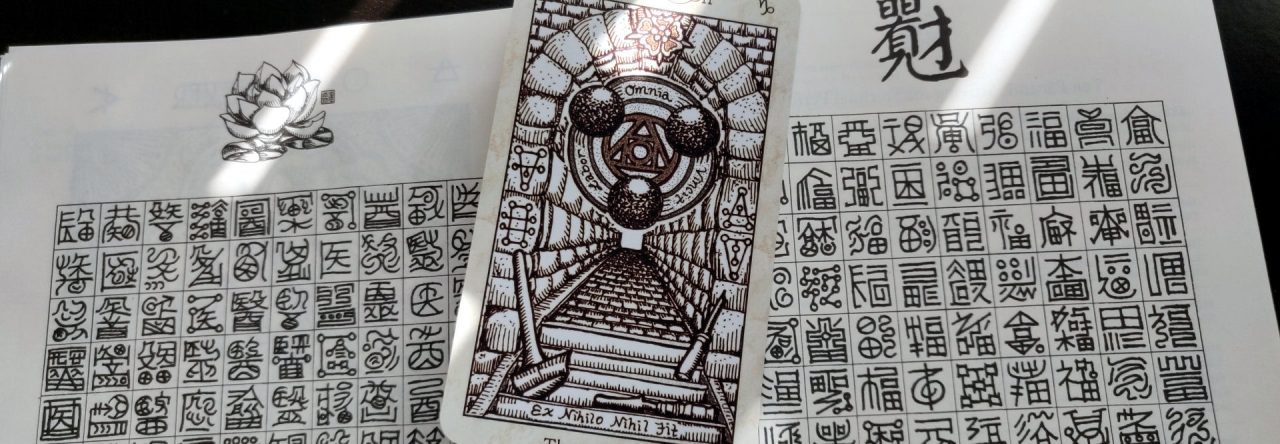
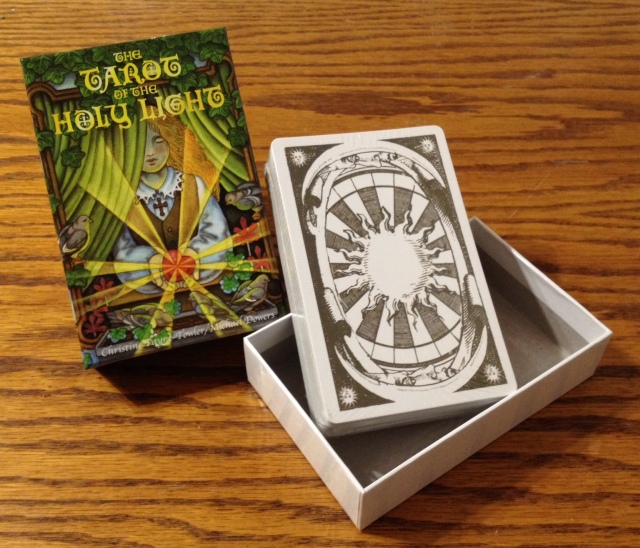
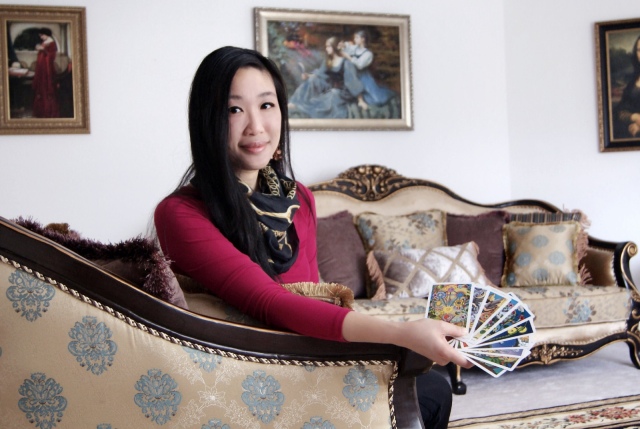


No ready for this deck…..
LikeLike
Great review, thank you…
LikeLike
Thanks for another great review! Great photo BTW!
LikeLike
I *love* this deck. I’ve had it for a year or so but I’ve been using it a bit more eclectically than your impressively methodical approach described above. I’ve been working with it as a kind of reference point. Whenever I’m wanting to go deeper with a particular card I turn to Christine’s deck and commentary. Plus I enjoy just hanging out with the gorgeous artwork–love the Strength card, the Four of Cups is wonderful as is the Four of Wands and check out that Ten of Swords. I’m rather fond of the Queen of Wands, too.
If you want to really delve deeply get the app for this deck because not only can you carry the cards with you digitally but it comes with Christine’s extensive and extremely erudite commentary. Full and very detailed explanation of each card with its historical, astrological, psycho-spiritual context and so much more. She did an awesome reading for me last year, a very generous reader, Christine is! So glad to see this deck getting some press.
LikeLiked by 1 person
Do you think Apps give accurate result? Or do you draw the cards first, then have it displayed on App?
LikeLike
I don’t use apps at all for any of my professional readings. I don’t actually use apps for readings that I care about. I may from time to time play with them just for fun or kicks, however.
LikeLiked by 1 person
Oh, if the app Version of this deck comes with Christine’s commentary, more so than what comes in the little white booklet for the regular deck, then I might just get it for that reason alone. Otherwise normally I’m not that into tarot apps.
LikeLiked by 1 person
The main reason for Tarot apps IMO is that the full book is included with each deck. In the case of TotHL the commentary is extensive. Way more than you’ll get in the LWB. Hope that helps.
LikeLiked by 2 people
I usually draw cards with manually, then list them out on an App to journal and save, Fool Dog Apps are great for this, so the Apps I really love, I have an App to go with this 🙂
It’s only aud4.99…
LikeLiked by 1 person
Hey Rose! I’m also LOVING this deck as well. I can’t get enough of the imagery.
LikeLike
Getting the App first and see how it resonates, haa!
LikeLike
Pingback: Tarot of The Holy Light: A Continental Esoteric Tarot (A Book Review) | benebell wen
Pingback: The 3x3x3 Tag: Tarot, Oracle, and Other | benebell wen
Pingback: LXXXI Quareia The Magician’s Deck | benebell wen
Thank you, Benebell! THL is one of my favorite tarot decks, but I haven’t worked with it in a while. You have really rekindled my interest in it!
LikeLike
Pingback: Book Review of the Foundations of the Esoteric Traditions – benebell wen
I love my app! I would also love to own a physical deck, I love to look at it. It is very nice to have on my tablet. IT comes with me everyday and it makes it avaiable when other wise I would not have the oppertunity to use it.
LikeLike
Pingback: Love & the Devil | Awakening the Witch
Hey Benebell! Some of the links in this article have died.
Maybe they can be replaced?
Very attractive deck to me.
LikeLike
I just heard about this amazing person recently. She will be the main guest on an online tarot conference apparently as well . 🙂 I forgot the name of the event but Katrina Wynne is holding it!
Nothing is a coincidence! This tarot deck looks fantastic.
LikeLike
Pingback: Rota Mundi Tarot: The Rosicrucian Arcanum by Daniel E. Loeb – benebell wen
Pingback: Oracle of Dr. John Dee by John Matthews and Wil Kinghan – benebell wen
Pingback: #only10decks The 10 decks I’d take with me – benebell wen
Hi, Benebell, on the very first hyperlink to Tarot University (in the first paragraph, I think), the URL is missing the “:” so it returns an error message. Great review! I found my way here by wandering around looking at the books you shared in your recent Q&A part 2.
LikeLike